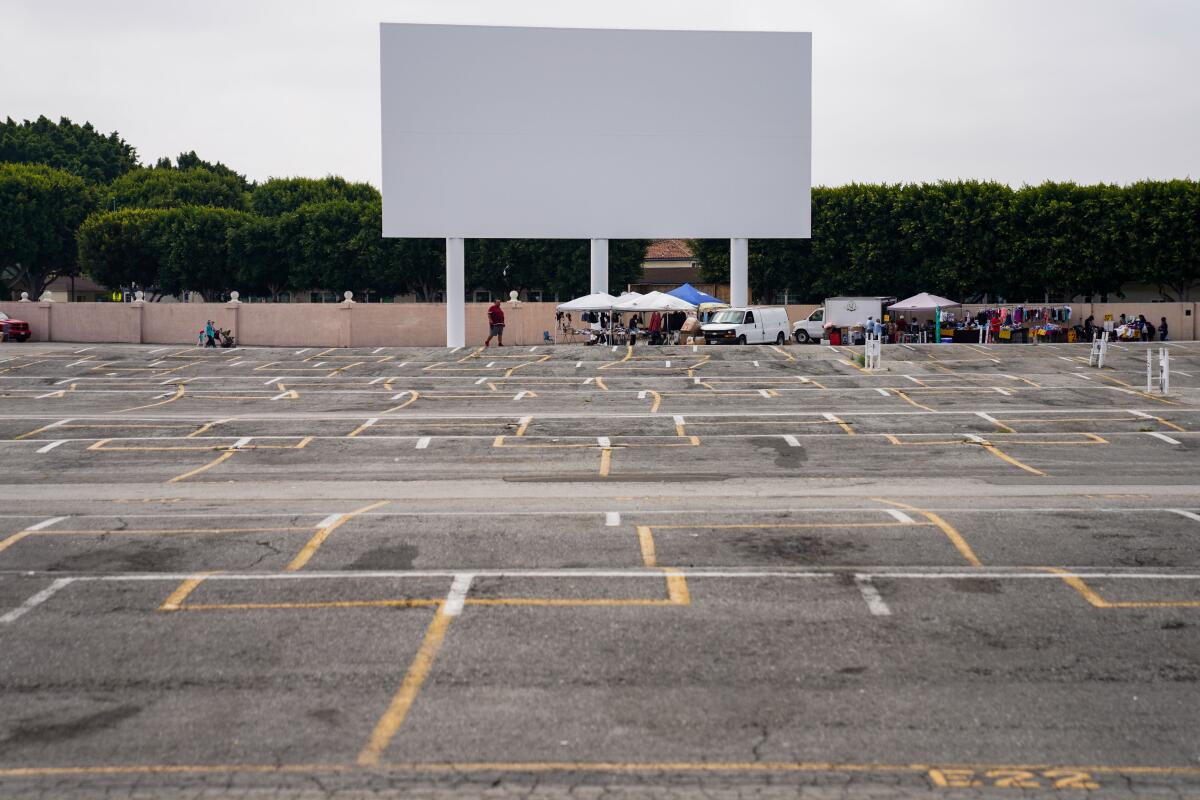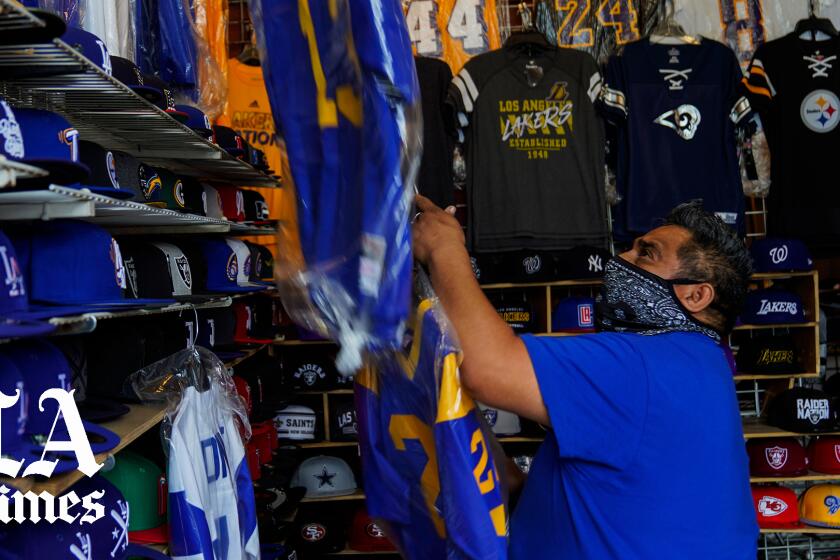Column: As an uncertain future looms, Los Angelesâ swap meet vendors live in the moment

Iâve spent many afternoons trying to make sense of the infinitely jumbled world of commerce that is the Los Angeles swap meet.
Itâs mostly clothing, jewelry, electronics and luggage stores, but thereâs also baby Jesus statues of every skin tone, oil paintings of Michael Jordan with his arm around Kobe Bryant and LeBron James, replica samurai swords, banh mi and live music.
Vendors produce custom T-shirts so rapidly that their slogans read like a screen-printed alternative to the newspaper front page: âRest in peace Nipsey Hussle,â âRIP Kobe and Gianna,â and the overly optimistic âI survived coronavirus 2020.â These days youâll see a lot of masks, gloves and face shields. And inevitably, you will turn a corner and find yourself caught in the menacing gaze of a parakeet from a swap meet pet shop.
Iâve been thinking a lot about swap meets lately, because as we confront deep economic uncertainty brought on by the COVID-19 pandemic, swap meets live in the moment. They are a flexible, agile form of commerce that creates public space and economic opportunity out of thin air and unused real estate, and they enable poor families to get what they need at a price they can afford and in a language they can understand.
In a new world where crowds mean danger, swap meets and the vendors who make them run struggle to stay afloat.
And no other business successfully serves so many different kinds of people at the same time â elderly Spanish-speaking video game fans who canât use the internet, Asian immigrants looking for bargains on kitchen supplies, kids with little or no allowance who nevertheless still need to pull off an outfit.
Last week, I checked on Syed Hussein, a swap meet clothing vendor from Pakistan whom I met before the pandemic hit and changed everything. I was surprised to see him back at work unpacking boxes with his wife. The swap meet was busier than ever and actually featured several new businesses. I asked Hussein if he was worried about the future and the ongoing healthcare crisis.
âWhat if the building is sold? What if we are kicked out? My friend, I donât know. Maybe someone will come in and shoot me and Iâll die tomorrow!â Hussein said, joking but not smiling.
Hussein and the people in the swap meet have always known something that most of us are just coming to grips with: The future is not guaranteed. A swap meet manager, whose name Iâm not using because he is in the country illegally, summed it up: âDown here, we live always in the moment. We want what we want, right away, and it doesnât matter if itâs good for us or not. Because the moment is sometimes all we have.â
I couldnât tell whether he meant it out of hope or despair.
::
Swap meets and flea markets are an old practice in the United States, and until the 1960s, they were mostly populated by white vendors who sold mostly secondhand goods outdoors, said Edna Ledesma, an assistant professor at the University of Wisconsin-Madison who has researched swap meets.
In the 1970s, Latino immigrants started selling cultural goods and affordable services at swap meets sometimes, and swap meets began to take on the look and feel of tianguis, or open-air markets in Mexico.
At the same time, the decline of drive-in movie theaters led to a proliferation of swap meets and flea markets, driven by property owners who sought ways to bolster their flagging profits by renting out their properties during the day. The streets and alleys of many outdoor swap meets are still laid out in the fanned pattern of drive-in movie parking lots, and many stalls were former parking spots, Ledesma said.
As swap meets exploded in number, a wave of imported goods from Asia flooded U.S. markets. Asian immigrants, mostly Korean, used their connections in the import/export industry to supply goods to swap meet shops and set up their own stalls. Swap meets began to feature new, cheap goods from Asia rather than secondhand possessions, and they started to resemble Korean bargain markets.
In Los Angeles, as investors fled South L.A. in the â80s and â90s, Korean immigrants bought the vacant and unused properties they left behind and turned them into indoor swap meets. The business appealed to immigrants who were shut out of the formal economy by discrimination, cultural barriers and lack of capital.
Selling to mostly Black customers, swap meets in South Los Angeles were the site of unprecedented and historic cultural interactions that helped give rise to West Coast hip-hop.
Steve Yano, a Japanese American from Whittier who owned a record store at the Roadium swap meet in Torrance, helped introduce Dr. Dre to Eazy-E. Wan Joon Kim, a South Korean immigrant, ran a record store in the Compton swap meet and sold N.W.A records when record companies were ignoring hip-hop.
L.A. swap meets, especially the Compton Fashion Center, became a celebrated part of hip-hop culture. In one of the two music videos for âCalifornia Love,â Tupac Shakur goes to the Compton Fashion Center so he can pick up a new outfit for a party at Dr. Dreâs house. Kendrick Lamar continued the tradition in his music video for âKing Kunta,â dancing on the swap meetâs rooftop.
But today the Compton Fashion Center is a Walmart Supercenter store. Itâs a testament to the fact that swap meets rarely inspire community pride. No swap meet enjoys historical protection, even though some are nearly a century old. Southern California city leaders actually considered them blights and regulated them as they would liquor and tobacco shops, with Gardena even adopting a moratorium on new swap meets.
In the â80s and â90s, swap meets acquired a reputation for selling fake or illegally obtained goods. Shootings in swap meets caused many leaders to conclude that the swap meets themselves were a public safety concern. In the city of Los Angeles, operating a swap meet requires a permit from the Board of Police Commissioners, and if criminal activity at a swap meet causes a rise in police spending, the swap meet operator may be required to compensate the cityâs general fund for the time.
Swap meets had a complicated relationship with the communities they served as well. Black residents accustomed to shopping at brand-name stores considered the swap meets a downgrade. The prospering businesses, mostly owned by Korean immigrants, took money out of the Black community, sparking tension in neighborhoods long robbed of resources.
At least 385 Korean American-owned swap meets were looted or burned down in 1992, and 191 swap meets were totally destroyed, according to Edward Chang, an ethnic studies professor at UC Riverside.
Even vendors themselves feel conflicted about the swap meet, which offers them economic opportunity but with a low ceiling. Some swap meet shop owners learn American business practices and move on to bricks-and-mortar spaces, but others, like Yoyo Juan, 68, an immigrant from Taiwan, get stuck there.
Juan started working at her parentâs stand in 1984 because âI was tricked,â she said in Mandarin, another joke with no smile. âI was the oldest and I was supposed to help my parents. Itâs a really inexplicable situation.â
She was 32 at the time, and now sheâs 68 with a lot of inventory that no one wants to buy anymore, a situation she describes as mo ming qi miao â inexplicable, baffling. When I saw her last week, she said she was getting ready to close up shop and return to Taiwan â if she can get a flight.
Jennifer Renteria, whose parents ran a bicycle shop in the Starlite Swap Meet in South El Monte, also had a love-hate relationship with the swap meet.
âIt was more hate than love, for sure,â Renteria said.
As a kid, she always tried to sign up for school activities that happened on weekends, which were usually reserved for helping out at the stand. She remembers lingering at the foot of her bed after her mother woke her at 5 a.m., half-asleep and waiting hopelessly for the infinitesimal chance that her mom wouldnât need her that day, which of course never happened.
But as she got older, she grew to appreciate the experience more â how a swap meet could let a kid with no domingo, or Sunday allowance, get into affordable nail polish and makeup, even if the brands were fake sometimes. She saw how their stand helped buoy the family when her father got injured and had to leave his job at the Santa Fe Railway. She grew fond of what she called her âswap meet wardrobeâ â the potentially real Unionbay T-shirts, the definitely fake Converse, the cheap Casio watches sheâd accessorize with as a teenager.
In high school, Renteria and her brother took over the family bicycle stand. One month they were late on a payment, and the swap meet operator tried to take away their space. All of a sudden, she felt rage, grief, disbelief.
Renteria and her brother collected signatures for a petition, lobbied their neighbors and fought until they reached a compromise that allowed them to use the space on Sundays.
âAs much as my brother and I hated the swap meet, it was like, you canât do this to us! How dare you? Weâve been so loyal, people know us, this is our spot,â said Renteria, who now works as a designer at the Smithsonian Institution in Washington.
They couldnât imagine their lives without that space â this former parking spot for a drive-in movie theater on which they had built their lives and, against all odds, made into their own.
More to Read
Sign up for Essential California
The most important California stories and recommendations in your inbox every morning.
You may occasionally receive promotional content from the Los Angeles Times.












